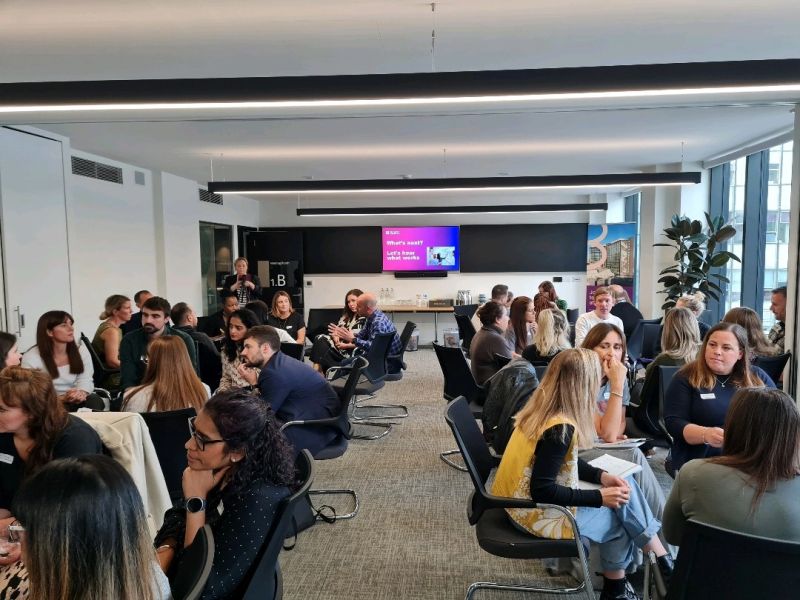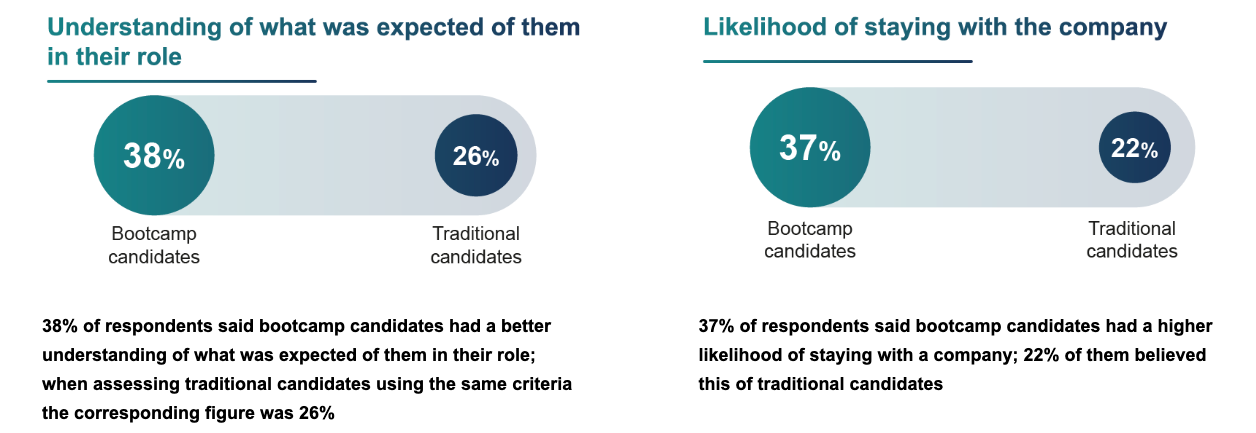Leeds Diversity in Tech Roadshow: Insights and Reflections

Earlier this month, we hosted another instalment of our Diversity in Tech roadshow in Leeds, sponsored by Channel 4. The event brought together senior leaders from tech companies, tech professionals and advocates for diversity and inclusion (D&I).
The roadshow is part of a series of events hosted by the TTC across the UK to promote diversity and inclusion in the tech industry. The Leeds event focused on three key themes:
- Increasing the supply of tech talent through new Routes to tech, including reskilling and returners programmes.
- Supporting career progression for mid-level and senior tech talent in underrepresented groups, such as women and ethnic minorities.
- Improving retention and engagement of diverse tech talent through inclusive management.
The event featured keynote addresses from Debbie Forster, CEO of the Tech Talent Charter (TTC), and Grace Boswood, Technology Director at Channel 4. Our CEO delved deep into the latest findings from the Diversity in Tech annual report, placing emphasis on actionable interventions employers can use to strengthen the growth, promotion and retention of underrepresented groups.
Here's a recap of key takeaways from the leaders at the roadshow:
Addressing the diversity problem in senior tech roles
We asked…
How can employers support the mid-to-senior-career development of their employees with consideration to the different needs and types of tech positions, while ensuring that interventions to improve diversity and inclusion in senior tech roles do not stray into tokenism?
Recommendations:
-
Don’t expect that you can take a formulaic approach to diversity in senior roles. It's essential for leaders to understand the deeper reasons behind diversity and inclusivity measures, rather than merely checking boxes. Diversity at senior levels is a complex, multivariate issue, and regular introspection and education on diversity topics are crucial to come up with improvements that actually work, over ones that are common or sound good. This is supported by our Open Playbook on how to equip managers with the tools to support career development.
-
Customised training/progression programs for the IC (Individual Contributor) track and leadership track. Offer tailored training programs based on the specific needs of different tech roles, ensuring that employees in both engineering and strategy roles have access to relevant skill development. This will also enable you to look at whether certain groups are engaging more in certain tracks over others e.g. women in tech funnelling towards managerial positions rather than more senior IC roles. Learn how to support and promote ICs development in tech by Flagstone Group.
-
Regular training for senior leadership on the value of diversity. This training should help senior leaders to understand the importance of diversity and inclusion, and how to create a more inclusive workplace. Training helps leaders to better understand the experiences and challenges faced by their employees from different lenses of diversity both inside the Equality Act and beyond it.
-
Celebrate employee diversity at all levels of seniority. Encourage employees at all levels of the business to share their unique backgrounds, cultures, and experiences, fostering a culture of understanding and appreciation. It helps to break down stereotypes and biases that can harm diversity at senior levels.
-
Clear channels of communication. Ensure that messages about diversity and inclusion are clear and impactful. If you are focusing on diversity at senior levels, be clear about it. Avoid overcommunication, which might dilute the message, and give your messaging power by ensuring it is consistent from the top of the organisation
-
Choose your language carefully to avoid diversity and inclusion being associated with junior employees only. Terms like "Grad-scheme" and “apprenticeship” have common associations with early-in-career folks. Consider how whether tenured tech talent, career-changers, switchers and returners, will relate to your messaging.
-
Mentorship initiatives. Pair mid to senior-level employees with experienced leaders in their specific domain, fostering growth and knowledge sharing. This also helps with creating ready-made succession planning and helps to develop a sense of investment in incumbent senior role holders in those who may follow them.
-
Career Pathway Clarity. Clearly outline the potential career trajectories within the organisation, giving employees a clear vision of growth opportunities. These should provide as much legitimacy to upskilling, career switching and sideways career moves as it does to more traditional upward ladder movement.
Learn more about diversity and inclusion for tech leaders in our report here.
How do you improve senior-level diversity in SMEs where teams are smaller and employee turnover may be lower?
We asked…
In SMEs, can diversity and inclusion in senior leadership be improved without employee turnover?
The Diversity in SMEs survey highlighted that there's a wide variety of attitudes toward diversity and inclusion in smaller companies, we spoke to our SMEs at the event to understand their approach towards diversity and inclusion. .png?width=1200&height=675&name=Diversity%20in%20SMEs%20Survey%202021%20%20(1).png)
Recommendations:
-
Focus on upskilling and developing internal talent within their role and through role expansion. This provides employees with access to training and development opportunities. This can support them with career development within their existing role (upskilling) or to move sideways into other roles that may offer them the progression they desire (re-skilling). This is even more important to do in smaller organisations if there are fewer opportunities for career development through traditional promotion processes (moving “up” from one role to another).
-
Pick the most useful metrics based on your organisation's circumstances. SMEs might find metrics such as diversity in leadership programs, mentorship initiatives and internal training uptake to be more useful measures of how they are talent planning for diversity in senior roles, even if the board at that time does not reflect it.
-
Provide employees with the opportunity to attend industry conferences and workshops. This is a great way for employees to stay up-to-date on the latest trends and developments in their field, and to network with other professionals.
Learn how to create a successful diversity and inclusion strategy here.
On onboarding tech talent from tech skills programmes successfully
We asked…
What actions can employers make internally to ensure new hires from non-traditional tech routes are successfully integrated into the organisation and how can this differ between early-career, retraining and returner programmes?
 Findings from the Routes to Tech Research.
Findings from the Routes to Tech Research.
Recommendations:
-
Address the perception that talent from tech bootcamps or career change courses are not as capable as traditionally educated talent. Companies can do this by educating themselves and their employees about the value of hiring from non-traditional tech routes. They can also highlight success stories from similar recruits, mentors and role models. Note: our Routes to Tech research found that amongst tech hiring managers tech bootcamp talent was rated as highly as traditionally skilled tech talent, and on factors like retention and understanding of their role expectations, more highly than traditionally educated tech talent.
-
Understand how unconscious bias works and what the most effective approaches are to redress it. Invest in training for staff, especially management to understand, how unconscious bias works, and that whilst there is no way to remove it, there are successful ways to manage its effects. Not only will this bring benefits from improving diversity within teams, it will improve the quality of decision-making across the board.
-
Develop comprehensive onboarding so that new tech talent is set up for success in the short and long term. Onboarding should be tailored to the individual’s background, skills and experience, and the role they are filling. The purpose of onboarding is not only to prepare the new hire for the tools and architecture of their work but just as importantly to ensure they are fully able to embed themselves within the organisation's team structure, social framework and culture.
-
Mentorship is essential for new hires from early-in-career routes to tech, retraining programmes, and returner programmes. Mentors provide support and guidance on a range of topics, including career development, navigating the workplace, and building relationships, all of which are key parts of talent progression through an organisation.
-
Create a buddy system. Using a buddy system without a time limit ensures new hires understand their roles and responsibilities and have informal peer support once official onboarding periods have ended. This also supports network-building in the long term.
-
Address hybrid working challenges. Acknowledge the challenges posed by hybrid working, such as remote workers feeling disconnected. Consider how you can bring people together without creating a disadvantage for folks who rely on autonomy or flexibility in their work setup. For example, instead of mandatory days in an office, plan in-person working days as offsites, where the focus is less on presenteeism and more on connection. This helps hold leadership accountable for their choices around flexible working policies and can help build trust with employees on why they are important.
Our Routes into Tech report found that bootcamp candidates outperformed traditional candidates in all categories measured, including professionalism, likelihood of staying with a company, technical skills, soft skills, understanding of job expectations, and interpersonal skills. This finding highlights the need for employers to change their perceptions of bootcamp graduates and educate themselves about the value of hiring talent from non-traditional tech backgrounds.

To read the full Routes into Tech report, click here.
Systemic Changes to Support Inclusion
We asked…
How can organisations ensure their inclusive working policies are put into practice and how can management be held accountable in a practical way?
Recommendations:
-
Regular Policy Audits. Periodically review and update policies to ensure they align with the organisation's evolving needs and challenges. These audits will determine areas of strength and areas needing improvement.
-
Management Accountability. Hold managers accountable for the implementation of inclusive policies within their teams and ensure they are receiving regular training.
-
Employee Feedback Systems. Implement feedback systems to gauge employee satisfaction with inclusive policies and identify areas for improvement.
-
Create employee resource groups (ERGs) for underrepresented groups. ERGs can provide a safe space for employees to share their experiences, support each other, and advocate for change.
For more insights on ERGs, please visit here.
The TTC events are a great opportunity to learn about new diversity and inclusion initiatives and to share your own ideas and experiences. To find out more about TTC events and how you can get involved, please visit here.